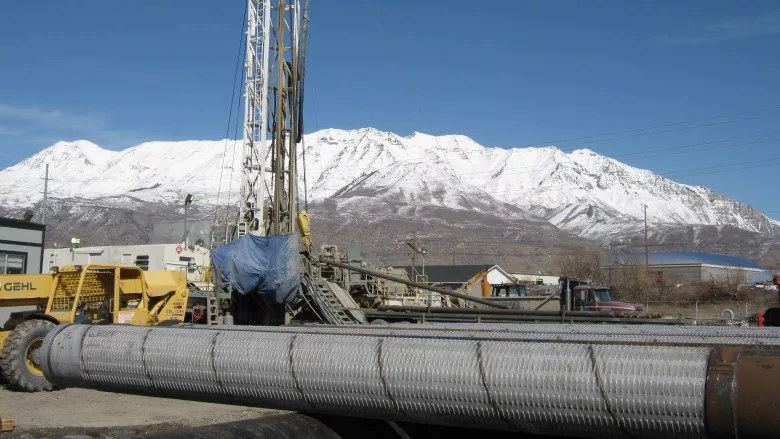The Basics of Reverse Circulation Drilling
Tips for Flooded Reverse, Air-Assisted Reverse and RC Pipe Size

Flooded reverse circulation drilling works well for large-diameter holes in fairly unconsolidated formations that need some hydrostatic head. Source: Central Utah Water Conservancy District / The Driller file
RC, or reverse circulation, drilling is a tried and true drilling method in certain circumstances. Drillers usually use it on large-diameter holes because it is faster and easier to clean the hole. The fluid and cuttings flow up the drill pipe and down the annulus. In softer formations, this causes less washout and makes sampling faster and more accurate because cuttings are not contaminated by sloughing formation off the hole walls. They also come up the drill pipe very fast, giving an accurate formation log.
Flooded Reverse Circulation Drilling
There are two general methods of RC. First is flooded reverse, where fluid is introduced through a flow ditch to the hole to keep it full. This works well in fairly unconsolidated formations that need some hydrostatic head.
The trick here is to have enough water supply to keep up with any losses to the formation. In extreme loss situations, high-viscosity mud can be introduced to help stabilize the hole, but it might take a lot of mud. Usually in these situations, we drill with direct circulation until we can get enough casing set to get into more stable formations.
This RC method can be used with either a large centrifugal pump to maintain flow, or air lift. A centrifugal pump system will need a “rock catcher” between the Kelly hose and the pump to catch cobbles big enough to damage the pump.
Air-Assisted Reverse Circulation Drilling
For more on reverse circulation drilling, click here!
The other common RC method is air-assisted reverse. This method runs a fairly small air line inside the drill pipe to lift the cuttings. It is very successful because you do away with pump priming problems. It works very well in limestone (and similar) formations that produce water. You won’t have to haul water to the drill site; you’ll have to haul it off. It’s a good idea to have a good disposal plan in mind. Environmental requirements have changed in many areas, meaning you can't usually just run water into a nearby stream or lake anymore. Checking with the proper authorities is always a good idea.
I once worked on a team that drilled a well in Orlando, Florida, with this method. The well produced 400 or 500 gallons of water a minute that we had to get rid of. The disposal requirements were for very low turbidity, so we built a 4,000-gallon sand filter that did very well. Once filtered — since the water was potable from the producing formation — we had no problem pumping it to a nearby pond. We pumped through 4-inch lines and, where they crossed the road, we rented one of those heavy, plastic ramp deals that fire departments use, to let traffic pass.
The Importance of Drill Pipe Size in RC Drilling
One important factor in RC drilling is drill pipe size. Generally, the bigger the better. I find that 4½- or 5½-inch works well. I have done it with 2 7⁄8-inch, but plugging is a problem and penetration is slow. This is due to the air line inside, which is usually 1 inch. I use PVC pipe.
The length of the air line depends on the depth to the static water level. Usually, at least 50 percent submergence or more is good. The deeper the air line the better, but you might run into compressor issues if you get too deep. I’ve done well with 500 feet of air line on a 3,000-foot hole.
One key problem in RC drilling is bit or drill pipe plugging. Large holes — and the large bits used to make those holes — make a lot of cuttings. Those cuttings can only be transported to the surface so fast. You need proper air flow and instrumentation to succeed at RC drilling. Not enough air volume and the cuttings won’t keep up. Too much air, and there isn’t enough room for the cuttings with all that air in the pipe.
In 4½-inch drill pipe, a 185 cfm compressor has worked well for me. I can throttle it just a little to find the “sweet spot.” A good, accurate air gauge is critical. When you get on bottom and start the air, it will settle down to a steady number and you are ready to put the bit on bottom. Keep your eye on the gauge. Any drop in air pressure indicates bit plugging. If that happens quit drilling, pick up and vigorously work the pipe. This should dislodge the plug. If not, you may be able to pump into it to open the pipe. If not, you’re are going to have to come out of the hole to clear the plug. Prevention is the better plan. I usually pick up at a 5-pound pressure drop.
The last thing that comes to mind about RC drilling is development. In our area, we produce from limestone. With RC, you are constantly pulling formation water into the hole. This means no cuttings that have to be developed out later. We just set the test pump, and let ’er rip. Often, turbidity clears in minutes. Sampling is also faster and more accurate. For some reason, geologists like that.
Hope this helps and keep ’er turning to the right.
For more Wayne Nash columns, visit www.thedriller.com/wayne.
Looking for a reprint of this article?
From high-res PDFs to custom plaques, order your copy today!

